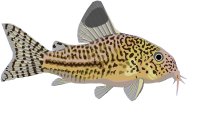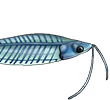Hi all,
About a year ago, I bought a group of juvenile Synodontis eupterus misidentified as S. nigriventris. I did not have enough space for them at the time, so once I realized the mistake, I returned all except the runt of the litter, which I kept.
One year and one larger tank later, I learned why it had been the runt - the humeral process is missing entirely, leaving the gills uncovered (if you look closely, you can see the 'indent' that the humerus would've covered in some images). The fish also holds its pectorals at a diagonal angle, which is not my experience with healthy synos. Possibly the process acts as a support point in normal fish, and it's compensating for the lack of that support?
In any case, it looks like the catfish equivalent of opercular defects in koi fry that you're supposed to spot and cull early on. It would appear that salmon can have a similar issue (https://fishhistopathology.com/?p=2307).
This is a farm-bred fish from Eastern Europe, so I'm assuming hormones were involved. I've also noticed mouth and tail defects in other fish at the LFS, e.g. a later shipment from the same source had an animal with a fused tail fin. Did anyone else have similar experiences with fish bred with the assistance of hormones, or did I get extremely unlucky?
In addition, I keep this fish in a 200L community tank with a striped raphael as the only other large fish (currently around 12 cm TL, but not fully grown). Do you think the raphael is a potential danger, e.g. by puncturing the exposed gills while jostling for food? Lastly, I believe this is pure S. eupterus, but I'm no expert and I know S. batensoda hybrids are common. Do you think the defects might be caused by hybridization?
Sorry for the poor image quality, my phone camera isn't exactly the best (and fish are not especially cooperative during feeding time!)
Birth defects in captive-bred Synodontis
-
ludivine21
- Posts: 1
- Joined: 17 Jan 2025, 12:04
- Location 1: france
- Location 2: bordeaux
- Contact:
Re: Birth defects in captive-bred Synodontis
It sounds like your Synodontis eupterus has developmental defects likely linked to farm breeding practices, possibly hormone use or hybridization. Monitoring the interactions with your striped raphael is wise, as exposed gills could be vulnerable during feeding or territorial jostling.
- naturalart
- Posts: 774
- Joined: 07 Jan 2006, 05:38
- I've donated: $45.00!
- My images: 3
- My cats species list: 41 (i:21, k:11)
- My aquaria list: 6 (i:3)
- My Wishlist: 3
- Spotted: 18
- Location 1: Oakland
- Location 2: California
- Interests: catfish, nature
Re: Birth defects in captive-bred Synodontis
Well on the surface, it looks like a pure eupterus, but i'd never put money on that.
Second i cant see where the process is missing but the gill cover (opercula) does look deformed. Deformed opercula (and missing humeral processes) can be a result of inbreeding, hybridization, genetics, etc. But if its just deformed opercula, then that could also, very well be a result of environmental degradation.
And finally, there is a small chance your rapheal cat will injure the eup. The eup is very quick and 'intelligent', and they would have to be doing a lot of fighting for that to happen.
Thank you for taking care of this 'runt' who's options otherwise would likely be very limited.
Second i cant see where the process is missing but the gill cover (opercula) does look deformed. Deformed opercula (and missing humeral processes) can be a result of inbreeding, hybridization, genetics, etc. But if its just deformed opercula, then that could also, very well be a result of environmental degradation.
And finally, there is a small chance your rapheal cat will injure the eup. The eup is very quick and 'intelligent', and they would have to be doing a lot of fighting for that to happen.
Thank you for taking care of this 'runt' who's options otherwise would likely be very limited.




